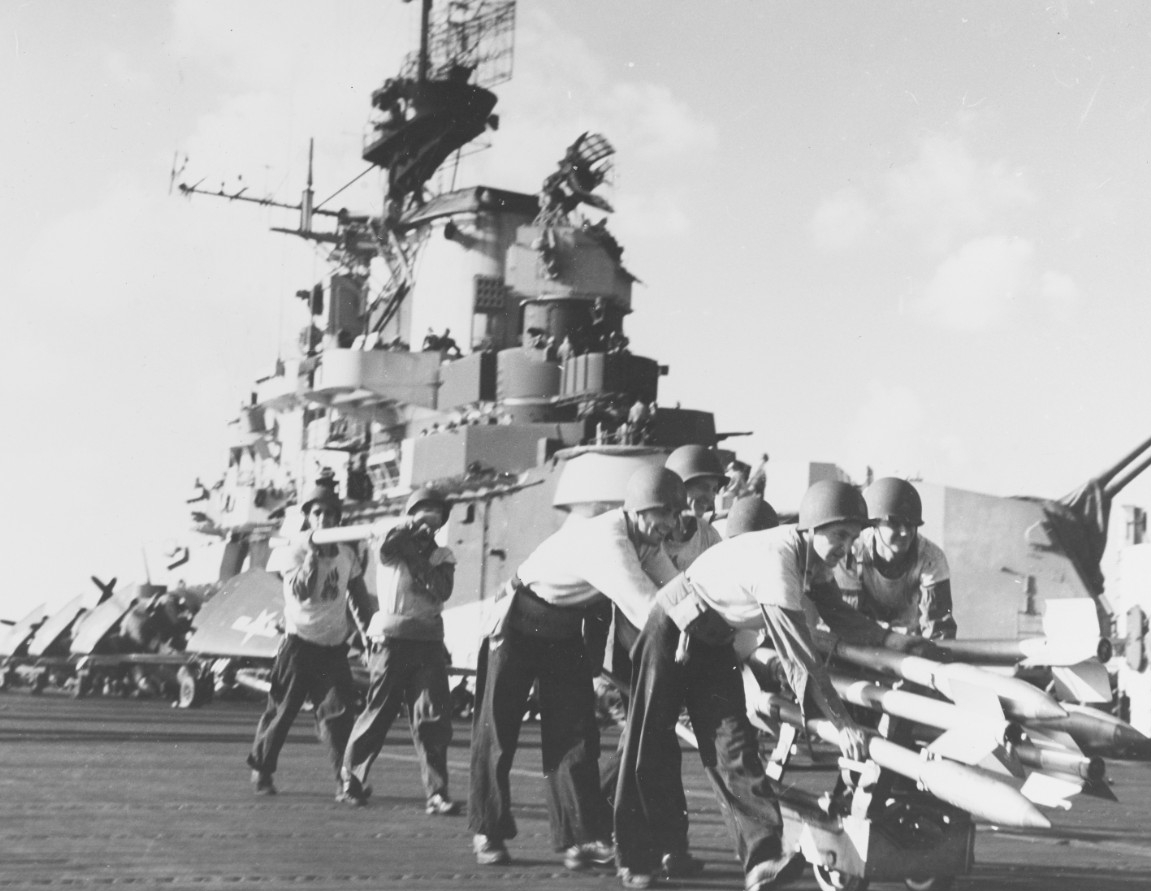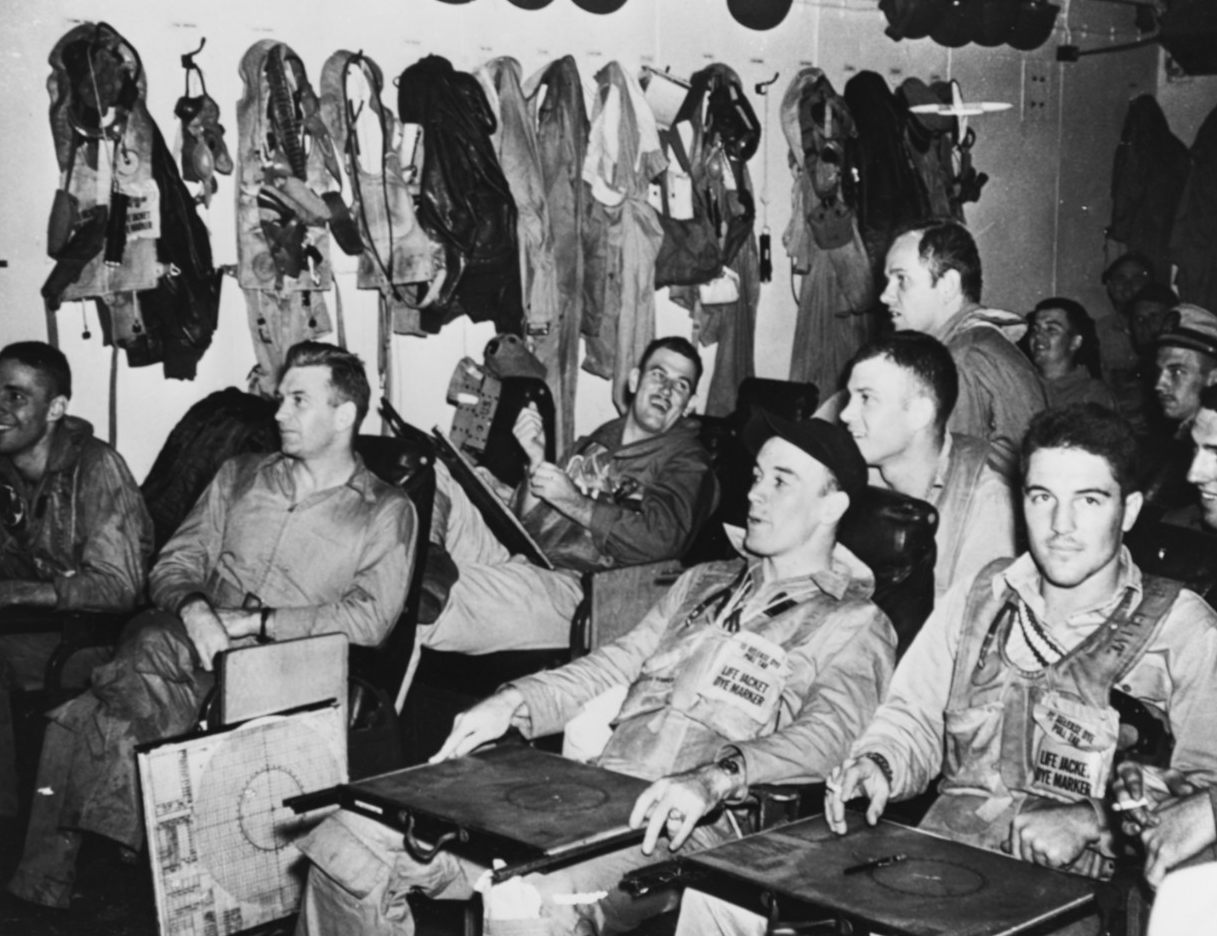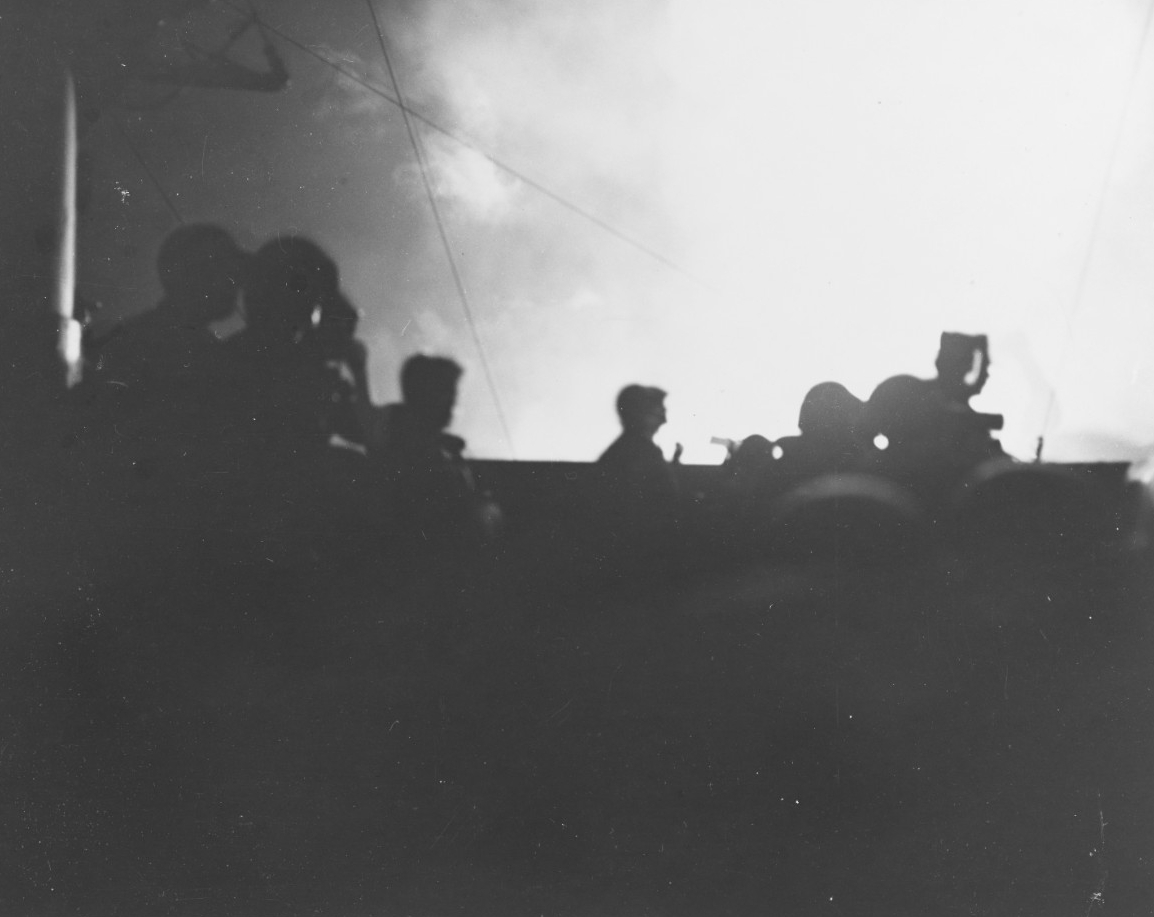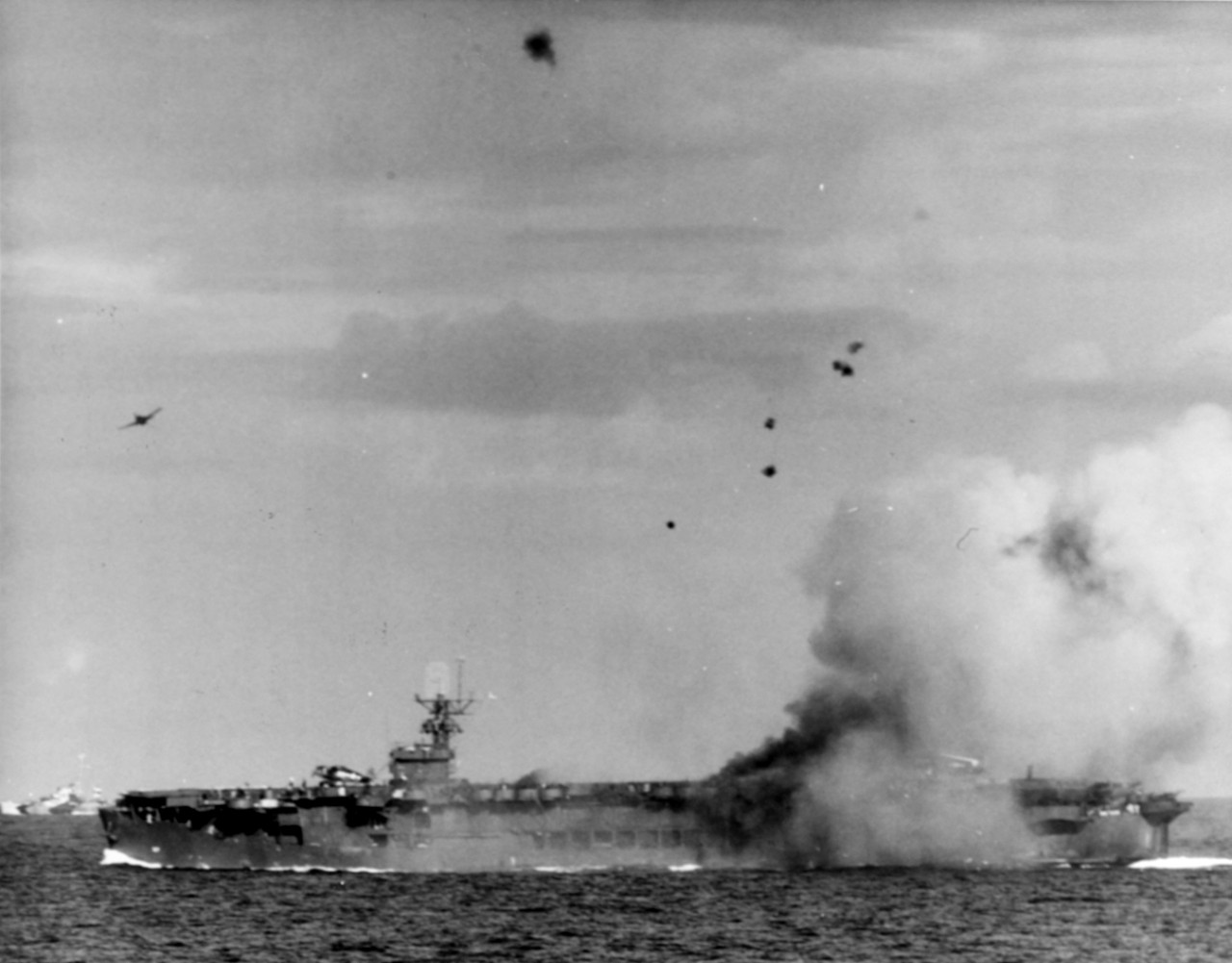H-038-1: Battle of Leyte Gulf—A Synopsis
Crewmen on USS Hancock (CV-19) move 3.5-inch rockets (with 5-inch-diameter warheads) to planes while preparing for strikes on Formosa, 12 October 1944. Carrier strikes on Okinawa and Formosa in early October were instrumental in reducing Japanese air capabilities prior to the Battle of Leyte Gulf later that month (80-G-281338).
For those who are short of time, this article provides a relatively short synopsis of the battle. For a more complete treatment please see attachment H-038-2.
“CRIPDIV 1”—U.S. Carrier Attacks on Okinawa and Formosa, 10–16 October 1944
On 10 October 1944, four U.S. carrier task groups (over 1,000 aircraft) of Admiral William F. Halsey’s Third Fleet commenced massive diversionary strikes on Okinawa and the Ryukyu Islands, followed by strikes on Formosa. The strikes caused the Japanese to prematurely execute the air portion of their Sho (“Victory”) plan for the decisive battle of the war. In the massive air battles that followed, approximately 500 Japanese aircraft were shot down or destroyed on the ground (more than in the more famous “Marianas Turkey Shoot”). The loss of these aircraft had profound impact on the subsequent Battle of Leyte Gulf, as the Japanese surface strike groups were deprived of air cover during the battle.
During the strikes on Formosa, Japanese aircraft did succeed in hitting the heavy cruiser USS Canberra (CA-70) and the light cruiser USS Houston (CL-81) with torpedoes, nearly sinking both. Despite the great risk of follow-on strikes, Halsey opted not to scuttle the gravely damaged ships, but to tow them over 1,300 miles to safety. There was the possibility that the Japanese might sortie a surface force to attempt to finish off the two cruisers, which became known as “CRIPDIV( Cripple Division) 1” and “BAITDIV 1. The enemy could then be ambushed by Halsey’s force. The Japanese did not take the bait. The two cruisers also survived, thanks to superb damage control and a lot of luck.
Battle of Leyte Gulf, 23–26 October 1944: U.S. and Japanese Forces
U.S. Navy forces during the Battle of Leyte Gulf were divided into two major components. The U.S. Seventh Fleet, commanded by Vice Admiral Thomas C. Kinkaid, was subordinate to General Douglas MacArthur, and was responsible for direct support to the Leyte landings, and included six pre-war battleships and 18 escort carriers, with about 450 Navy aircraft. The U.S. Third Fleet, commanded by Admiral William F. “Bull” Halsey, was subordinate to Admiral Chester Nimitz, and included 17 fast aircraft carriers and 6 fast battleships, and was responsible for providing covering support to the Leyte landings, but had the authority to pursue and engage major Japanese fleet forces if the opportunity arose.
Japanese navy forces were executing Operation Sho in defense of the Philippine Islands. The objective of the Japanese operation was the troop transports and supply ships of General MacArthur’s landing force (this was completely at odds with decades of Japanese navy doctrine and training that stressed the overriding importance of fleet-on-fleet engagement, just as in the U.S. Navy for that matter). The main Japanese effort was a force of five battleships and seven heavy cruisers under the command of Vice Admiral Takeo Kurita that would transit through the central Philippines with the intent to attack the U.S. landing force in Leyte Gulf from the north. A second force of two battleships and a heavy cruiser, under the command of Vice Admiral Shoji Nishimura, would attack Leyte Gulf from the south via Surigao Strait with intent to draw U.S. Seventh Fleet forces away from Kurita’s main effort. A force of four carriers and two hybrid battleship-carriers, under the command of Vice Admiral Jisaburo Ozawa, would operate northeast of Luzon with the intent to draw the U.S. Third fleet forces away from Leyte Gulf in order to aid Kurita’s main effort. A fourth Japanese force, under Vice Admiral Kiyohide Shima, including two heavy cruisers, was never really integrated into the Japanese plan, and Shima decided to follow Nishimura through Surigao Strait.
The Invasion of Leyte, 20 October 1944
The initial landings on Leyte went comparatively well, although the campaign on the island would eventually turn into another bloody slog, costing over 3,500 U.S. Army lives. Japanese air attacks badly damaged the Australian heavy cruiser HMAS Australia and the light cruiser USS Honolulu (CL-48). The destroyer USS Ross (DD-563) barely survived striking two Japanese mines.
Pilots of Torpedo Squadron 13 (VT-13) in their ready room aboard USS Franklin (CV-13), 24 October 1944, just before the Battle of the Sibuyan Sea. They are watching as the position of the Japanese fleet is posted. VT-13's commanding officer, Lieutenant Commander Larry French, is second from the left, with a navigation board beside his chair (80-G-290733).
The Battle of Palawan Passage, 23–24 October 1944
On the night of 22–23 October, the U.S. submarines Darter (SS-227) and Dace (SS-247) intercepted the main Japanese force of battleships and heavy cruisers (the Ist Diversionary Striking Force) under the command of Vice Admiral Takeo Kurita, as it transited from Brunei (Borneo) toward the central Philippines. Darter sank Kurita’s flagship, the heavy cruiser Atago, and severely damaged the heavy cruiser Takao, while Dace sank the heavy cruiser Maya, costing Kurita three of his ten heavy cruisers before the Battle of Leyte Gulf even started. Darter subsequently ran aground, but her entire crew was rescued by Dace.
USS Tang (SS-306) Sunk by Own Torpedo, 23–24 October 1944
During a night surface attack against a Leyte-bound Japanese convoy, the submarine Tang (SS-306) was accidentally sunk by one of her own torpedoes at the end of a series of actions that earned her skipper, Commander Richard O’Kane, the Medal of Honor. Nine of Tang’s crew survived to be captured by the Japanese; five of the survivors had made a successful ascent using the Momsen Lung from the submarine 180 feet below on the bottom. Tang was the most successful U.S. submarine in World War II in terms of number of ships and tonnage sunk.
Greatest U.S. Navy Ace: Commander David McCampbell, 24 October 1944
On the morning of 24 October 1944, a large force of Japanese aircraft attempted to attack Halsey’s carriers operating off the east coast of Luzon, Philippines. Many of the U.S. carriers’ aircraft were flying en route to attack airfields on Luzon and Vice Admiral Kurita’s battleship/heavy cruiser force (Ist Diversionary Striking Force), which had been sighted transiting easterly through the Sibuyan Sea, leaving the U.S. carriers with a weakened defensive capability. Nevertheless, Commander David McCampbell and his wingman engaged the Japanese force. McCampbell shot down nine Japanese aircraft (the most in a single sortie by any U.S. pilot in history) and his wingman shot down six. McCampbell would finish the war as the highest-scoring U.S. Navy “ace” of all time with 34 kills in the air (and 20 on the ground) and would be awarded the Medal of Honor.
USS Princeton (CVL-23) Lost to Japanese Air Attack, 24 October 1944
Despite the heroics of Commander McCampbell and his wingman, one Japanese dive bomber succeeded in penetrating U.S. defenses and scored a direct hit on the light carrier USS Princeton (CVL-23), which was operating east of Luzon, causing serious damage. With most of the crew evacuated, damage control teams were making progress when a massive secondary explosion doomed the ship and killed 233 crewmen on the light cruiser USS Birmingham (CL-62), which had come alongside to help fight the fires.
Battle of the Sibuyan Sea, 24 October 1944
Multiple waves of U.S. Third Fleet carrier aircraft attacked VADM Kurita’s force in the Sibuyan Sea as it was heading toward the San Bernardino Strait exit to the Philippine Sea. Unfortunately, the U.S. planes kept attacking the same ship over and over again (the super-battleship Musashi). Musashi absorbed incredible punishment from numerous bombs and torpedoes before she finally sank, and the heavy cruiser Myoko was badly damaged and forced out of the battle. Inflated battle damage claims and the fact that Kurita turned his force westerly (temporarily as it turned out) led Admiral Halsey to believe that Kurita’s forces had been beaten and were retreating, freeing him to send his carriers northward to attack a force of four Japanese aircraft carriers that had been sighted northeast of Luzon late on that same day. Halsey’s decision left San Bernardino Strait unguarded, opening the way for Kurita’s force to reach Leyte Gulf from the north.
Air Strikes in the Sulu Sea, 24 October 1944
On 24 October, scout/strike groups from Enterprise (CV-6), Franklin (CV-13), and Intrepid (CV-11) attacked a group of three destroyers as well as Vice Admiral Nishimura’s “southern” force in the Sulu Sea, hitting the battleship Fuso with two bombs and sinking a destroyer. Nevertheless, both Vice Admiral Nishimura’s force of two battleships (Yamashiro and Fuso) and a heavy cruiser, and Vice Admiral Shima’s force of two heavy cruisers (which had not been attacked), continued undeterred en route to a planned nighttime forced passage of Surigao Strait, with Shima’s force trailing behind Nishimura’s.
Sinking of “Hell Ship” Arisan Maru—Greatest Loss of U.S. Life at Sea, 24 October 1944
On 24 October 1944, a U.S. submarine, probably Shark (SS-314), torpedoed and sank the Japanese “hell ship” Arisan Maru, which unbeknownst to the submarine was carrying over 1,700 U.S prisoners of war. Most of the POWs survived the sinking, only to be left at sea by the Japanese. Ultimately, only nine survived. Shark was then sunk with all hands by the Japanese escorts.
The Battle of Surigao Strait: Last Battleship Versus Battleship Action, 24–25 October 1944
Famous as the last battleship vs. battleship action in history (which it was), a force of six older U.S. battleships (five of which were Pearl Harbor attack survivors, two having been sunk and raised) and numerous cruisers and destroyers under Rear Admiral Jesse B. Oldendorf crossed the “T” of a Japanese force of two battleships, a heavy cruiser, and four destroyers on a sacrificial diversionary mission attempting to force their way into southern Leyte Gulf via Surigao Strait. It probably should more rightly be remembered as the most successful surface torpedo attack in U.S. Navy history. In reality, the Japanese ships were trapped in the confines of the strait (so, “crossing the T” was pretty much a foregone conclusion), and first ran a gauntlet of patrol torpedo boats and destroyers. Three Japanese destroyers and the battleship Fuso were sunk, and the battleship Yamashiro was badly damaged, all by torpedoes from U.S. destroyers, before they even came in range of the U.S. battleships. Yamashiro fired back ineffectively, yet continued fighting despite absorbing massive amounts of punishment from the U.S. battleships until yet more torpedoes from destroyers finally put her under. Both battleships went down with massive loss of life. Only the severely damaged heavy cruiser Mogami limped away to be subsequently sunk by air attack. For the second time, the destroyer Shigure emerged as the sole survivor of a major battle.
Although utterly defeated, the commander of this force, Vice Admiral Shoji Nishimura, accomplished his mission of drawing U.S. forces of Vice Admiral Thomas Kinkaid’s Seventh Fleet to the south side of Leyte Gulf to open a way for Vice Admiral Kurita’s force to come in from the north, via San Bernardino Strait. A second Japanese force of two heavy cruisers, one light cruiser, and four destroyers under Vice Admiral Shima turned back after the light cruiser Abukuma was badly damaged by U.S. torpedo boats, his flagship, heavy cruiser Nachi, was damaged in a collision with battered Mogami, and after Shima determined that forcing the strait would be futile. A U.S. PT boat was lost and the destroyer USS Albert W. Grant (DD-649) was caught in a crossfire and badly damaged by both U.S. and Japanese salvos. However she survived thanks to her damage control.
Future CNOs Lieutenant Elmo R. Zumwalt, Jr., and Lieutenant (j.g.) James L. Holloway III participated in the Battle of Surigao Strait aboard destroyers, and both were awarded Bronze Star Medals with Combat Vs.
The Battle of Cape Engano, 25 October 1944
Admiral Halsey’s aircraft sank all four aircraft carriers in the Japanese decoy force, including Zuikaku, the last surviving Japanese carrier from the Pearl Harbor attack. Zuikaku and the light carriers Zuiho and Chitose were sunk with large loss of life by U.S. carrier aircraft; the damaged Chiyoda was sunk by gunfire from U.S. cruisers near dusk. In going after the Japanese carriers (which only had about 110 aircraft between them), however, Halsey left San Bernardino Strait unguarded, enabling Vice Admiral Kurita’s battleship force to get through and attack the escort carrier task group Taffy 3 off Samar with the potential to attack U.S. transports still off the beachhead at Leyte. (The Battle of Cape Engano, the Battle off Samar, and the kamikaze attacks on the escort carrier task group Taffy 1 all occurred simultaneously, commencing at daylight on 25 October.)
First Kamikaze Attacks, 25 October 1944
At the same time that Task Unit 77.4.3 (Taffy 3) was fighting for its life off Samar against Kurita’s battleship force, the Japanese launched the first dedicated kamikaze attack of the war against Taffy 1. At 0740, this hit and damaged the escort carrier Santee (CV-29), the first ship to be hit by a kamikaze, and a few minutes later hit Suwanee (CVE-27). During the kamikaze raid, Santee was also hit by a torpedo from a Japanese submarine and, the next day, Suwanee was hit by another kamikaze. Both ships survived their ordeal, although Suwanee suffered 107 dead from the combined attacks. Those that died on Santee would be the first of several thousand U.S. sailors to be killed by kamikaze attacks before the end of the war. One of Taffy 1’s escorts, Eversole (DE-404), was torpedoed and sunk by a Japanese submarine on 28 October 1944. (The Battle of Cape Engano, the Battle off Samar, and the kamikaze attacks on Taffy 1 were all occurring simultaneously.)
The Battle off Samar, 25 October 1944
I’ve already covered the Battle off Samar in H-Gram 036. This was the culminating action of the Battle of Leyte Gulf, in which for all the Japanese mistakes and losses, their complex plan almost worked. Vice Admiral Ozawa’s sacrificial decoy carrier force had drawn off all of Halsey’s Third Fleet carriers and battleships to the north, and Vice Admiral Nishimura’s sacrificial attempt to force his way through Surigao Strait had drawn Kinkaid’s Seventh Fleet battleships to the south. This had opened the way for Vice Admiral Kurita’s battleship/cruiser force to enter Leyte Gulf and engage the U.S. transports off Leyte. The only thing standing in Kurita’s way was a small force of six escort carriers, three destroyers, and four destroyer escorts, immortalized by their radio call sign “Taffy 3.” At that point in time, despite all the U.S. Navy’s technological, numerical, and intelligence advantages, Taffy 3 found itself quite by surprise facing an overwhelmingly superior Japanese force of four battleships, six heavy cruisers, two light cruisers, and eleven destroyers.
The Battle off Samar was decided by the sheer raw courage of the commanding officers and crews of the ships in Taffy 3, as well as that of the pilots and gunners in Taffy 3 and Taffy 2, which turned certain defeat into a hard-fought victory. The USS Johnston (DD-557, lost in action) and her skipper, Commander Ernest Evans (posthumous Medal of Honor), led the way in an epic sacrificial solo torpedo attack. However, the fight put up by Hoel (DD-533, lost in action), Heerman (DD-532), Samuel B. Roberts (DE-413, lost in action), John C. Butler (DE-339), Raymond (DE-431), and Dennis (DE-405) was one of the most heroic actions in the entire history of the U.S. Navy. The actions of the six escort carriers, Fanshaw Bay (CVE-70), Kitkun Bay (CVE-71), Kalinin Bay (CVE-68), White Plains (CVE-66), St. Lo (CVE-63, lost in action) and Gambier Bay (CVE-73, lost in action) demonstrated extraordinary courage under fire. For all their superioriy, the Japanese suffered even worse, losing three heavy cruisers (Chokai, Chikuma, and Suzuya), with a fourth badly damaged (Kumano), mostly due to the extraordinarily courageous attacks of the carrier planes from Taffy 3 and Taffy 2. Although St. Lo survived the initial battle, she was hit by a kamikaze at 1051, becoming the first U.S. warship sunk by a kamikaze attack in the war.
Halsey’s Response to Taffy 3’s Plight
Due to the convoluted theater communications architecture, Admiral William F. “Bull” Halsey did not receive the messages from Vice Admiral Kinkaid about the desperate situation of Taffy 3 until almost 1000 on 25 October. By this time, it was actually too late to do anything, although Rear Admiral McCain’s TG 38.1 launched a long-range 330-mile strike that inflicted some damage on Vice Admiral Kurita’s force after it was already heading back to San Bernardino Strait. Finally, in response to the famous “Where is TF 34? The world wonders,” message from Admiral Nimitz, Halsey turned his fast battleships around and sent them toward San Bernardino Strait, knowing full well it was already too late to intercept Kurita before he transited the strait. The futile race of Halsey’s battleships, first to the north toward Vice Admiral Ozawa’s carriers, and then south toward Kurita’s battleships, would become derisively known (with 20/20 hindsight) as “Bull’s Run.”
Sources include: “Battle of Leyte Gulf: ‘Calmness, Courage, and Efficiency’,” by NHHC Historian Martin Waldman, September 2019; The Defenders of Taffy 3: Analysis and Retelling of the Battle of Leyte Gulf, by Byron G. Como, self-published, 2019—this is a great new work with the most detailed analysis of the Battle off Samar that I have seen, and sheds new light on many of the actions; Storm over Leyte: The Philippine Invasion and the Destruction of the Japanese Navy, by John Prados, New American Library, 2016—the best book by far that integrates all aspects of intelligence (both sides) into the battle; The Battle of Surigao Strait, by Anthony Tully, Indiana University Press, 2009; The Little Giants: U.S. Escort Carriers against Japan, by William T. Y’Blood, Naval Institute Press, 1987—the best book about escort carriers; Last Stand of the Tin Can Sailors: The Extraordinary World War II Story of the U.S. Navy’s Finest Hour, by James D. Hornfischer, Bantam Books, 2004—a “must-read” by anyone intending to lead sailors in battle; The Battle for Leyte Gulf: The Incredible Story of World War II’s Largest Naval Battle, by C. Vann Woodward, Skyhorse Publishing, 2007—an updated re-issue of an early classic; History of United States Naval Operations in World War II, Vol. XII, The Battle of Leyte Gulf, by Samuel Eliot Morison, Little, Brown and Co., 1958—still a useful foundational treatment to which all others are indebted; Anthony Tully’s website combinedfleet.com—best source for detailed information on Japanese ships; Naval History and Heritage Command’s Dictionary of American Fighting Ships (DANFS), with recently updated detailed information on U.S. ships involved in the battle.






